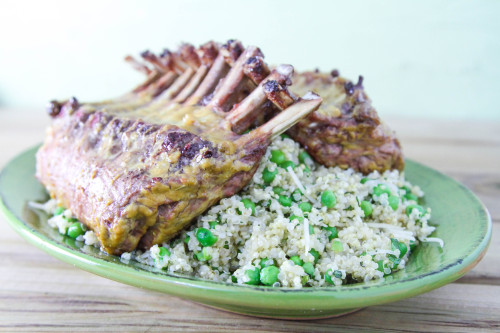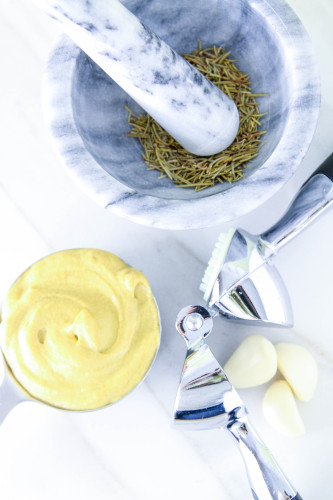Coming home to a package full of Silere frenched racks of lamb will undoubtably be a highlight of my 2015. From a Kristin perspective, I love lamb {and not just because I get a good chuckle out of saying something so similar to “I love lamp”}. I truly love lamb. It’s tender, tasty, and makes for such a special dinner. From a FoodFash perspective, I love lamb even more. My favorite dishes to prepare are those that require minimal ingredients to compliment the main act. Lamb has such a distinct flavor, calling for the simplest of seasoning and an even more simple side. And… it couldn’t be an ounce more beautiful to photograph.
Being selected by Marx Foods to review such a lovely cut of meat? Yeah, a total highlight!
Within minutes of receiving the lamb-licious package, I started researching what constitutes a quality cut. Through some time with the internet and the restaurant operations team I work with, I found that one should evaluate taste, texture, fat, and how the lamb is bred. I prepared the racks per Julia Child’s instruction {minus the bread crumbs} and served with a delicate mint, parmesan, and sweet pea quinoa.
I started off with evaluating fat and breeding before putting the meat in the oven.
Fat – The Silere racks of lamb have slight marbling and a generous fat cap. I prefer the leanest cuts of meat, so I was really satisfied with the marbling in the Silere racks. Once the meat was cooked to mid-rare, there wasn’t a fatty interior bite to be had. However, the fat cap was a different story. Even roasting at a high temp did little to dissolve the fat cap, which I later found to be both good and bad. Beginning with the “bad”, marinade has a difficult time penetrating through fat and crusting the fat cap side of the rack has little purpose if you’re like me and plan on trimming the fat immediately. That being said, roasting the rack with the fat cap facing up creates a shield that traps water in the meat, benefitting the meat by keeping it moist. Since my goal was subtle flavor and no crust, keeping the fat cap did no harm. And lastly, the Silere frenched racks arrived truly “frenched”. They barely required any fat trimming between the ribs, which was a huge time saver!
Breeding – When comparing Colorado lamb to New Zealand lamb, New Zealand lamb historically has a negative rap for breeding lamb for wool production first and meat production second. Silere lamb, though from New Zealand, is bred with meat production in mind. And much like the prestigious Colorado variety, Silere lamb graze naturally on native herbs and grasses, are free of hormones and antibiotics, and are raised to a mature 18 months of age.
After roasting the frenched racks, I was able to evaluate the fun parts: taste and texture.
Taste/Texture – The Silere frenched racks had a flavor that was unmistakably lamb, but was very delicate in the gaminess department – a perfect combination for me since, as mentioned above, I favor subtle and simple flavors over those that are overpowering. And the texture was super smooth and tender, almost resembling that of a nice filet. Both of these qualities, subtle gaminess and smooth texture, can be attributed to how the lamb was raised, what the lamb was fed, and how long the lamb was allowed to mature.
Not only was the entire FoodFash dinner table beyond satisfied with the quality of the Silere frenched racks, they enthusiastically requested that I prepare the Silere loin fillets ASAP!
If you found this review informative, please take a minute to vote for this post here!
Although I received compensation to review product provided by Marx Foods, the recipe and opinions in this post are completely my own and based on my experience.









Kristin a fabulous article! I adore food education and not only was this informative but I was drooling through all the photos. I could take a big plate of everything!
I’ve never cooked lamb (and rarely eaten it). After reading this, I must give it a go!